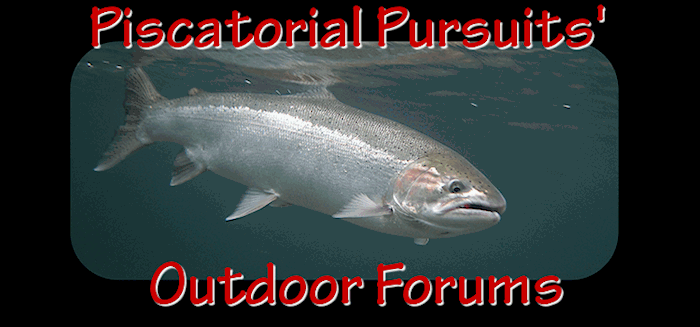B.C. salmon: something's not fishy
By MARK HUME - Toronto Globe and Mail
Something dreadful is happening to the rivers on Vancouver Island. Pool by
pool, riffle by riffle, they are dying.
To a casual passerby, glancing down from one of the slick new bridges on the
Island Highway, nothing seems amiss. Rivers like the Cowichan, Nanaimo,
Little Qualicum, Englishman, Trent and Tsable look just as beautiful as
ever, running from under the mossy, green forests to the blue waters of
Georgia Strait.
Mike McCulloch knows better.
Mr. McCulloch, a fisheries technician with the B.C. Conservation Foundation,
helps organize small teams of swimmers that are responsible for taking an
unusual annual census. They pull on wet suits against the bone-numbing cold,
and snorkel the rivers that flow out of Vancouver Island's rugged mountains.
They are looking for an increasingly rare species of salmon known as
steelhead. They aren't finding many.
The Gold River, on Vancouver Island's West Coast, historically had runs of
as many as 5,000 steelhead.
Last year, swimmers counted 900; this year they found 35.
"The magnitude of decline is overwhelming," said Mr. McCulloch. There are
worse statistics. In the little Trent River, which should have 100
steelhead, the snorkel team found only two. Both females.
In Goldstream, a small river just outside Victoria that spills from one
dappled pool to another, there should be several hundred steelhead waiting
to spawn. The swimmers found none.
The trend is repeated in river after river. The fish population data,
compiled by swimmers who peer under banks and dive into the gloomy darkness
of deep pools, is mathematically plotting the path to extinction.
"When you get down to one or two fish in a stream we call it
quasi-extinction," Mr. McCulloch said. "At zero, it is termed extirpation,
meaning the species is extinct locally."
Steelhead rivers on Vancouver Island have been in trouble for several years,
but never have the numbers been so low. "It's a situation that's getting
quite desperate," Mr. McCulloch said. "We're only a life cycle away from a
spiral into oblivion."
Steelhead aren't like other salmon on the Pacific Coast. They are believed
to be the progenitor species, the fish that spawned all the other kinds of
salmon.
There are six species of wild Pacific salmon, each filling its own niche in
the ecosystem. Some, like pinks, are small but prolific. Others, like
chinook, are fewer in number but grow to immense sizes. But only one, the
steelhead, survives spawning. The irony is that, for reasons not fully
understood, steelhead, the survivors, are now dying out as a species.
Mr. McCulloch said habitat destruction is part of the problem. Vancouver
Island watersheds have been logged and many rivers run through heavily
urbanized areas. Some watersheds are dammed. Poor ocean survival, due to a
shift in temperatures, is a major factor affecting all salmon species.
Steelhead, which have been tracked all the way to the coast of Russia in
their Pacific migrations, have been the hardest hit. Because they live
longer in their freshwater phase, they have also suffered the most in the
rivers.
The B.C. Conservation Foundation, a non-profit group, is working jointly
with the provincial Ministry of Land, Water and Air Protection to restore
Vancouver Island steelhead. One plan, not yet funded, is to fertilize 15
rivers where nutrient levels are low because of declining salmon runs.
When salmon die after spawning, their bodies decompose, enriching the
watersheds and stimulating the growth of aquatic insects, which feed young
fish. But overfishing and habitat problems have robbed many rivers of the
massive salmon runs they once had, stripping the streams of nutrients.
Steelhead usually live for two years in freshwater before heading to the
ocean. If they are underfed, they will be too small to survive when they run
to the sea. Mr. McCulloch has been scrounging dead salmon from federal
salmon hatcheries and placing them in rivers as fertilizer, hoping to
stimulate the growth of baby steelhead. From the dead bodies of one species
they hope to revive another. In one experimental program, artificial
fertilization saved the Keogh River, where steelhead runs are stable and
salmon stocks are increasing.
Mr. McCulloch calls the Keogh "a beacon" in the darkness, but the
restoration project can't be copied without more money. The foundation and
government fisheries agencies need $4-million a year in excess of their core
funding, about double what they have. BC Hydro and some forest companies are
helping with corporate donations, but the federal government, which has
$1-billion to help beef farmers, which squanders millions on sponsorship
scandals and which dithers over endangered-species legislation, seems
oblivious to the steelhead crisis.
"There are too many rivers in trouble and not enough money," Mr. McCulloch
said.
Meanwhile, in the Trent, two females wait alone -- the last hope for a
river.
_________________________
No huevos no pollo.













 Previous Topic
Previous Topic Index
Index


